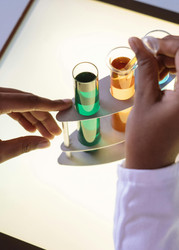How to Dye Liquid Silicone
Nov 10th 2023
Silicone, a type of synthetic rubber, is a go-to material for many DIY crafters due to its durability and versatility. It has a rubber-like consistency is renowned for its moisture and heat resistance. It is most commonly used to make reusable silicone molds, and can do so with incredible detail. One major aspect of silicone crafting is the appearance, and dying it can significantly help achieve the desired aesthetic. Therefore, it is helpful to know how to dye liquid silicone before you mold it into its final shape.
Materials and Tools
There are several key items you’ll need to dye your silicone safely. These materials include:
- Gloves
- Cleaning Cloths
- Acetone
- Liquid Silicone
- Container
- Silicone Pigments/ Dyes
- Silicone Paint
- Stir Stick
- Paint Brush
- Dish Washing Liquid
Safety Precautions
First and foremost, proper ventilation is a must when working with silicone rubber or similar substances. Some materials that dye silicone, including the silicone itself, can produce fumes. Neutral cure silicone has the least scent, while acetoxy silicone gives off a vinegar scent as it cures.
You’ll also want several pairs of rubber gloves. They will prevent any substances from sticking to or soaking into your skin. Put down protective plastic to keep the dye from staining anything while you work.
It is also vital to avoid eating, drinking, and smoking in areas where dyes and chemicals are used. Safety glasses may also be necessary.
Preparing to Dye Silicone
- Gather all necessary items, equip all safety gear (gloves, eye protection, etc.), and ensure the area is adequately ventilated. Keep all food and drinks away from the area. Use a container that can hold the amount of silicone you will use.
- Know your desired color palettes ahead of time. Having a list of colors makes it easier to narrow down the selection of paints and inks to choose from. Make sure to select a pigment compatible with the type of silicone you are using.
- Select the proper silicone pigment for your project. Carefully read the manufacturer’s instructions. Typically, the amount of pigment you add should be between 0.3% and 3% of the amount of silicone.
Choosing the Right Dye
You can use a few different methods to create custom silicone colors for your arts and crafts projects. Silicone coloring powder is one of the most commonly used and recommended silicone coloring methods. This coloring powder is relatively quick to dissolve, but may not disperse as easily as other methods. Liquid dyes may distribute more evenly but also require an attentive mix and careful curing.
Non-Basic Color Combinations
While creating colors like orange, green, and purple is fairly straightforward, less common colors take more effort. Teal, for instance, begins with a simple combination of blue and green, but may require some yellow to get the right brilliant shade. More advanced colors may take some trial and error, so use small batches until you find the perfect ratio of pigments to make your ideal shade.

How to Dye Liquid Silicone Rubber
Squeeze the desired amount of liquid silicone into the chosen container. Some pigment containers cannot dispense the small amounts needed, so you put the pigment onto a separate container or surface and use a small tool or stir stick to add tiny amounts at a time. Adding too much pigment won’t necessarily harm the silicone, but very little is needed, and this method can help avoid waste.
Pigments are powerful, so try to avoid letting them come into contact with anything you don’t want colored, and clean up any messes as soon as possible. Mix tiny amounts of pigment into the silicone, combining thoroughly with your stir stick. Make sure that the pigment consistently spreads before adding more. You can use acetone to remove pigment from unwanted surfaces, but proceed cautiously.
Once you’ve mixed the silicone, add a small amount of dish soap to the mold to prevent it from sticking and encourage clean extraction. Silicone can take on incredibly detailed and basic shapes if you’re careful when molding and demolding.
Regular caulk can take a long time to cure (up to several days). In contrast, you can activate silicone rubber more quickly by adding a small amount of cornstarch to the mixture.
Pour the silicone into the mold slowly and consistently to minimize the risk of air pockets and other blemishes. Follow the manufacturer’s instructions regarding curing.
Conclusion
Silicone rubber is a versatile material suited for home improvements, arts and crafts, and even for making activities for kids. By using the right combinations of pigment, there is an endless world of hues that you could use for these silicone projects, and the process is a lot simpler than it may seem.

